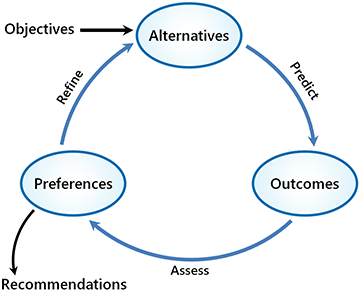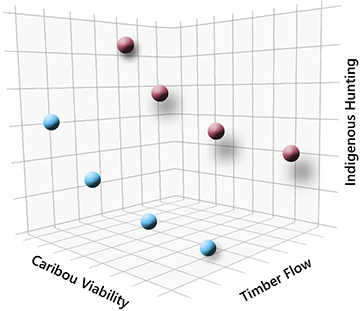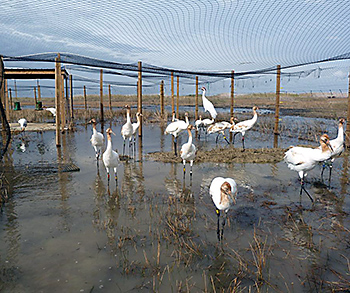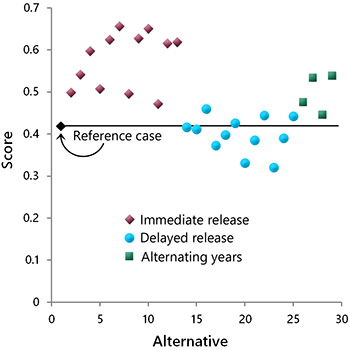Identifying the Optimal Approach
Stakeholder-Based Selection
The methods used to select a preferred management alternative depend on the type of decision and the level of stakeholder involvement. We will begin by examining methods based on structured dialog, which are commonly used when stakeholders are directly engaged in decision making. We will then turn to quantitative methods, which are best suited to operational decisions that are technical in nature.
As previously discussed, stakeholder groups generally do not make final decisions; they provide recommendations to a decision-making authority. Organizations and individuals engage as stakeholders because they perceive an opportunity to advance their interests, or because they are concerned that not participating might lead to undesirable outcomes. While they may be willing to work collaboratively, participating organizations tend to maintain fidelity to their own objectives and priorities.
For decision makers, stakeholder engagement provides insights for navigating difficult social trade-offs. Engagement also improves the likelihood that the decisions will be accepted and successfully implemented. Consensus is a welcome outcome but is not the overriding objective. In the face of strongly divergent views, a forced consensus is likely to be superficial, leaving difficult trade-offs unacknowledged and unresolved (Gregory et al. 2013). More important is the learning that occurs throughout the process, which takes several forms:
- Clarification of desired outcomes
- Identification of potential management actions
- Elimination of unworkable approaches
- Insight into the pros and cons of the best available management alternatives
- Identification of points of agreement and fundamental disagreement

Under SDM, the selection of a preferred management alternative is the endpoint of an iterative process of refinement (Fig. 10.5). Stakeholders will have differing perspectives and can help each other understand the implications and significance of the assessment results. Through structured dialog, the group can arrive at a common understanding of the strengths and weaknesses of individual alternatives, providing the foundation for further refinement. Good facilitation and a well-designed process are essential for making progress.
In many cases, the significance of the predicted outcomes may require interpretation. For example, if our caribou population is expected to double under a certain management alternative, is it now within its natural range of variation? Or is it still below the minimal viable population size? Or something in between? Each of these connotes a different level of risk, and it is this risk that is of fundamental concern.
Another issue is the level of uncertainty associated with the predicted outcomes. A management activity that directly affects an outcome can usually be predicted more reliably than an activity that functions through multiple intermediate steps. When uncertainty is an issue, the consequences of being wrong need to be taken into account. For example, when working with a critically endangered species, preference may be given to an approach with moderate effectiveness and high reliability instead of an approach that is predicted to work better but is subject to higher uncertainty.
If uncertainty is found to be high across all alternatives, it may prompt a search for management approaches that are robust under varying conditions, as discussed in Chapter 9. These are often referred to as “no regrets” options (Johnston et al. 2010). A complementary approach is to implement management actions within an adaptive management framework (see below).
The refinement process begins with the elimination of alternatives that everyone agrees are inferior across all objectives. The focus then shifts to ameliorating critical weaknesses in the remaining alternatives, either by modifying some of the actions or by adding new elements. Refinement may also entail the development of hybrids consisting of elements from different alternatives.
In the face of direct trade-offs, improvement in one objective is often associated with reduced performance in a competing objective. However, this relationship need not be linear. Many management actions exhibit diminishing returns above a certain threshold. Therefore, exploring different combinations of critical management actions may reveal a win-win scenario, or at least an alternative that represents a clearly optimal balance.
Once the alternatives have been refined as much as possible (or practical), the focus shifts to making recommendations. As previously noted, the aim is to identify and document areas of agreement and disagreement concerning the short-listed alternatives rather than to force consensus. One approach is to have each stakeholder provide a qualitative assessment of each alternative, using categories such as “strong preference,” “acceptable,” and “strong opposition.”
The final recommendations provided to decision makers should convey the pros and cons of each of the short-listed options and describe where the support and opposition lies. The intent is to inform decision makers of the range of options available and the core trade-offs that differentiate them. If any of the alternatives emerge with universal support, they should be highlighted. If agreement cannot be achieved, then it is useful to articulate what the main stumbling blocks are and what it would take to overcome them.
On public lands, government decision makers are responsible for making the final decision, drawing on stakeholder recommendations as well as their political judgment. Stakeholder groups provide insights and a depth of understanding that are otherwise unattainable. But a group’s determination of the optimal course of action—if it can agree at all—may not represent what is best in terms of the broad public interest. A government decision maker, considering all viewpoints, may arrive at a different conclusion.
Of course, government decision makers are subject to their own shortcomings and there is no guarantee that their decision will necessarily best serve the public interest either (see Chapter 3). Sometimes, no decision is made at all. For example, stakeholder recommendations may be accepted but not implemented, or the decision may be deferred for more research. Common pitfalls leading to derailment of the process at this stage include:
- Lack of certainty, lack of consensus, high political or financial cost, fear of failure, or simple inertia—all of which reduce the likelihood of decisive action
- Lack of alignment between what planners and stakeholders have done and the purpose, scope, and constraints set forth by the decision maker
- Decision maker bias and dysfunction, including collusion with powerful stakeholders making an end-run around the planning process
- Barriers to implementation arising from policy collisions and other jurisdiction and integration issues
- Closure of a political window of opportunity, which can occur as a result of a change in government
Box 10.4. Lackey’s Axioms of Ecological Management
Drawing on his experience as a manager with the US Environmental Protection Agency, Robert Lackey (2006) published what he called the axioms of ecological management. These axioms, presented in abridged form below, provide useful insights into the political realities of environmental decision making.
- Environmental management tends to be a zero-sum game, meaning that policy choices usually result in winners and losers. Therefore, compromise is normally necessary to craft a workable policy or plan. Win-win solutions are rare.
- It may seem that the most important factor in decision making is weighing the total benefits against the total costs. But in most cases, the question of who receives the benefits versus who will bear the costs is most important.
- In the face of a trade-off, the most politically viable decision spreads the benefits to a broad majority, with the costs limited to a narrow minority of the population.
- Potential losers are usually more assertive and vocal than potential winners and are therefore disproportionately influential in decision making. Money and political access can also determine influence.
- Many stakeholders will cloak their arguments as science to mask their personal policy preferences.
- Calls for more research are ubiquitous in resource management debates. However, even with complete and accurate scientific information, most policy issues remain divisive because differences are invariably over values and preferences, not science and facts.
- The meaning of words matters greatly, and arguments over their precise meaning are often surrogates for debates over values.
Systematic Searches

An alternative to trial and error refinement is to search for the optimal combination of management actions systematically. If there are three or fewer outcome measures to be considered, the results can be displayed graphically (Fig. 10.6). When there are many outcome measures to be considered, it is usually necessary to combine them into a composite score to facilitate comparisons.
To generate a composite score, the outcome measures must first be standardized. The intent is to express the outcomes on an equivalent scale so they can be added together. In addition, a weighting factor needs to be applied to each outcome to account for differences in the importance of each objective. In practice, it is hard to achieve agreement on weighting factors within a stakeholder group because of the divergence of opinion about what is important. Therefore, these sorts of quantitative comparisons are usually reserved for technical types of problems tackled by planning teams that share a common perspective.

Converse et al. (2013) provide an example of systematic search methods applied to the recovery of whooping cranes (Fig. 10.7). Managers wanted to establish an additional crane population using captive-reared chicks, but the supply was limited, and chicks were also needed to support the recovery of the core crane population. An SDM process was used to determine the best course of action. The main objective was to maximize the probability of achieving a new self-sustaining population while minimizing the number of captive-reared chicks used. Additional objectives included cost, public relations benefits, and the value of the information gained from the reintroduction program.
The management options all pertained to the release of chicks into the new population. The options included (1) the timing and duration of the releases, (2) the number of chicks per release, and (3) a potential ten-year delay in the onset of the program. These options were systematically combined into 28 alternatives, representing all relevant permutations. An additional alternative was used to represent the reference case of no additional releases.
The predicted outcomes of each alternative were recorded in a consequence table, and a summary score was calculated for each (Table 10.2). This score was then used in making comparisons and selecting a preferred option (Fig. 10.8). To calculate the summary scores, the outcomes were all standardized to a 0–1 scale and then weighted to reflect their relative importance. For example, the population objectives were weighted more heavily than the public relations objectives. The weights were obtained from a team of conservation practitioners representing different organizations involved in whooping crane recovery.
Table 10.2. The consequence table used in the whooping crane reintroduction example.1
| Objectives | Best | Worst |
| Population Viability2 | 0.289 | 0.122 |
| Diverted Chicks3 | 30 | 50 |
| Internal Cost (million $) | $9.95 | $11.10 |
| Partner Cost (million $) | $4.29 | $2.86 |
| Public Relations (0 or 1) | 1 | 1 |
| Information4 | 0.927 | 0.701 |
| Weighted Score | 0.657 | 0.320 |
1Source: Converse et al. 2013. Only the best and worst performing alternatives in the case study are shown.
2A weighted index of population viability based on multiple modelling methods.
3The number of chicks available for use in other reintroduction projects.
4Based on a formal value of information analysis.

When presented with graphical summaries like Fig. 10.8, it is important to recognize the influence of weighting decisions and the potential for subjective bias to creep in when defining the weights. Weighting decisions affect the ranking of alternatives, and as such, are integral to the determination of preferences.
In summary, systematic exploration provides an assurance that all combinations of potential actions have been considered. Having more data to work with also provides better insight into the nature of the trade-offs that exist. For example, it may be possible to determine whether a trade-off is linear or whether a break-point exists. The main shortcoming of this approach is that it is poorly suited to planning problems with many conflicting values and loosely structured alternatives. Had the whooping crane decision involved trade-offs with other species, or other social objectives, comparisons based on weighted summary scores would not have been appropriate. For these types of value-laden trade-offs, stakeholder-led dialog and learning is usually the preferred approach, despite its limitations.
Box 10.5 Mathematical Optimization
For certain well-structured planning problems, search methods based on mathematical optimization can be applied (Probert et al. 2011). In this approach, analytical techniques or computer-based optimization algorithms are used to identify the management option or combination of options that maximizes a selected objective (Rönnqvist 2003). Generally, only one objective can be optimized at a time, though other objectives can be included in the form of constraints. For example, the objective might be to maximize the volume of timber harvested, but a constraint could be added requiring the retention of a certain percentage of old-growth stands.
The main application of optimization methods in biodiversity conservation is in reserve design. As discussed in Chapter 8, programs such as Marxan can be used to identify the set of planning units that achieves representation targets at the lowest cost or with the smallest area. Few other conservation-related applications exist, mainly because of the difficulty in defining the mathematical objective function.

